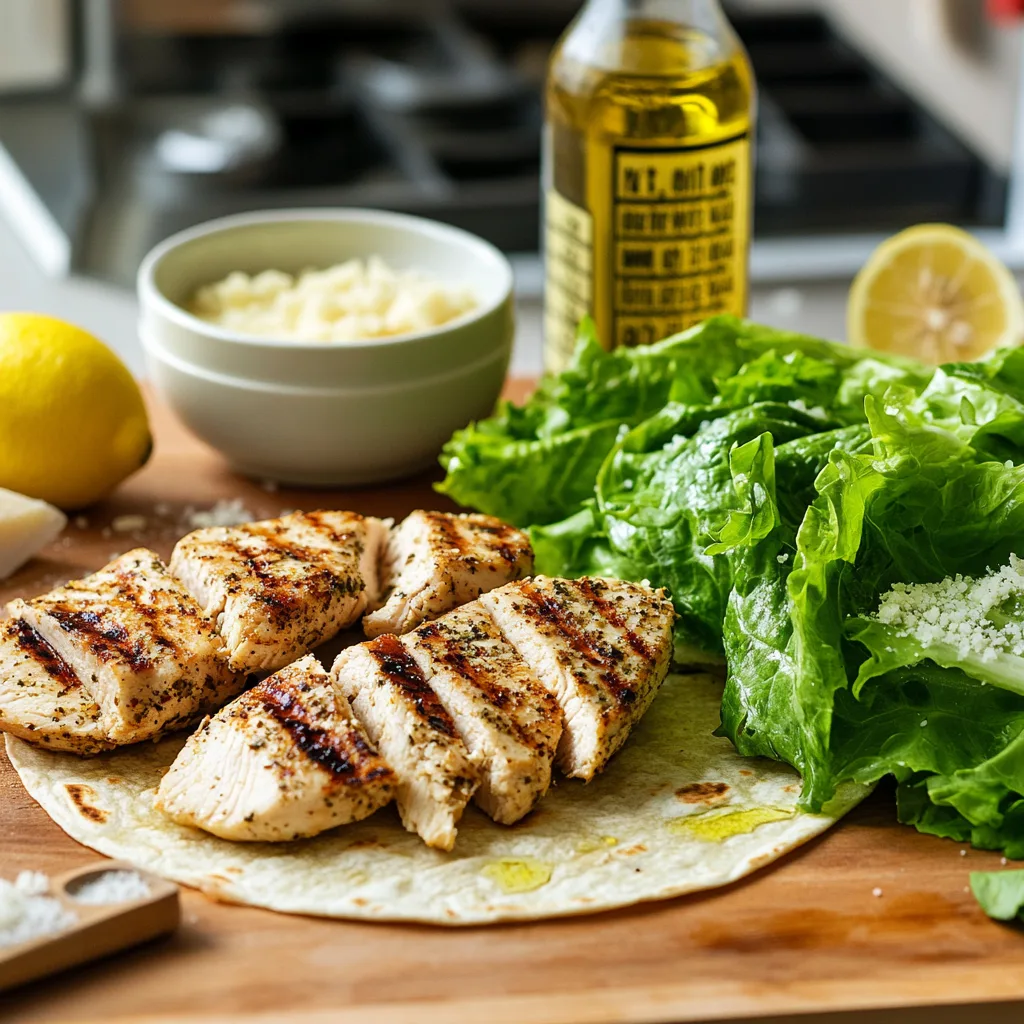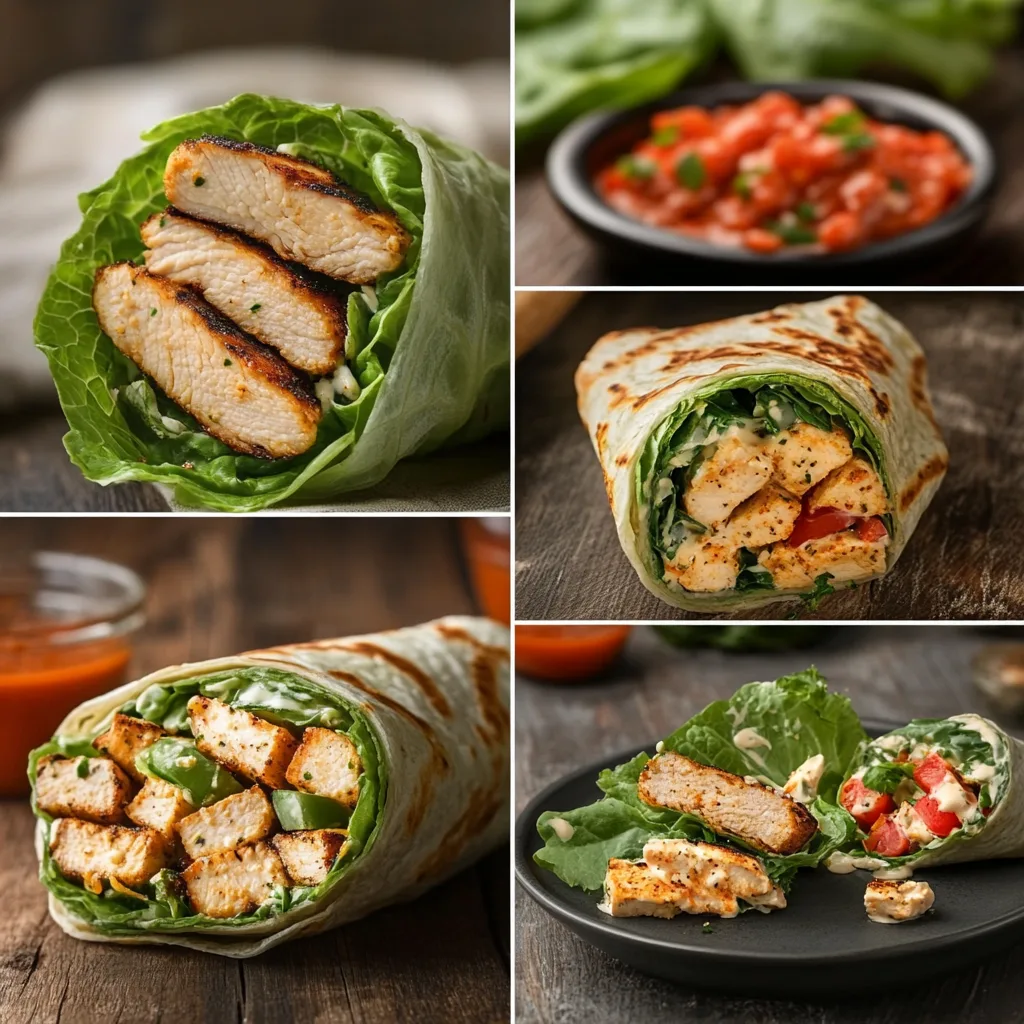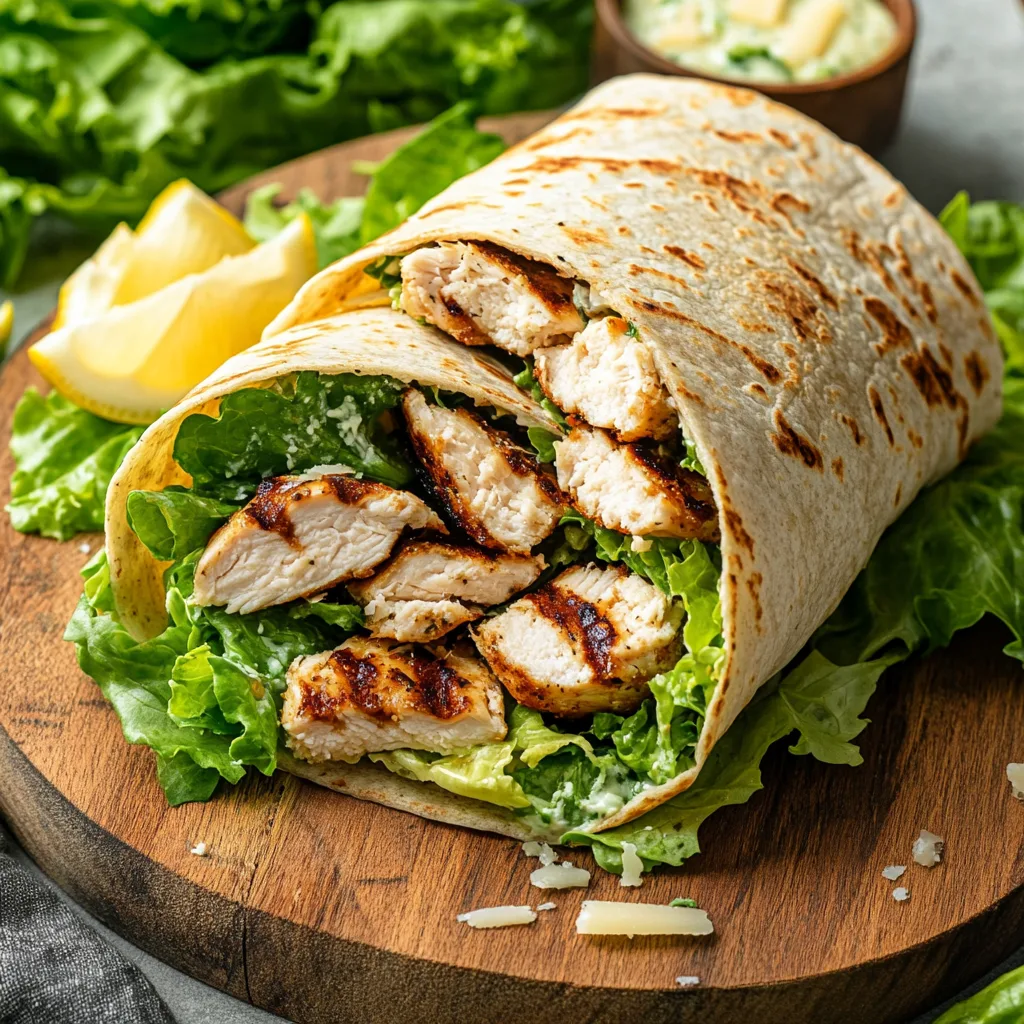Chicken Caesar wraps are a go-to meal for many of us, especially when we’re looking for something quick, tasty, and satisfying. But what about the calories? Whether you’re watching your waistline or just curious about what’s inside this popular wrap, this article breaks down everything from its nutritional content to tips for customizing it to your diet. Let’s uncover the details of chicken Caesar wrap calories and find out how you can enjoy this meal without guilt.
Introduction to Chicken Caesar Wraps
What Is a Chicken Caesar Wrap?
A chicken Caesar wrap is a modern twist on the classic Caesar salad. It combines tender grilled chicken, crisp romaine lettuce, shredded Parmesan cheese, and creamy Caesar dressing, all snugly wrapped in a soft tortilla. It’s a portable and satisfying option for lunch or dinner, making it a favorite for busy individuals and families alike.
Typically, this wrap includes a mix of proteins, fats, and carbs, but it’s the dressing and wrap choice that often steal the calorie spotlight. The exact number of calories can vary, depending on the ingredients and how it’s prepared. Keep reading to see why this matters!
Why Do Calories in Chicken Caesar Wraps Vary?
Ever wondered why some wraps feel like a cheat meal while others feel light and healthy? The answer lies in the ingredients. Caesar dressing, for instance, can be calorie-dense due to its creamy nature, while the type of wrap (white flour vs. whole wheat) can also play a significant role. Even the amount of chicken and added extras like croutons or bacon can change the nutritional profile.
Understanding the calorie content can help you make smarter decisions, whether you’re buying one on the go or preparing it at home. With that in mind, let’s dive deeper into the specifics of the wrap’s nutritional breakdown!
Nutritional Breakdown of a Chicken Caesar Wrap
How Many Calories Are in a Chicken Caesar Wrap?
The calorie count of a chicken Caesar wrap isn’t carved in stone—it shifts based on ingredients, portion sizes, and preparation methods. On average, a standard wrap made with grilled chicken, romaine lettuce, Parmesan cheese, Caesar dressing, and a flour tortilla contains around 500–700 calories. Sounds like a lot? That’s because small tweaks like extra dressing or larger tortillas can quickly increase the count.
For instance, swapping grilled chicken for fried chicken can pile on the calories, while choosing a whole wheat tortilla instead of a white one can slightly cut them. If you’re eating out, the calories may spike further due to larger portions or additional high-calorie toppings. Knowing these numbers can help you pick smarter choices without second-guessing yourself.
Breaking Down the Ingredients

Grilled Chicken: The Protein Powerhouse
Chicken is often celebrated for its protein-packed profile and relatively low fat content when grilled. A typical serving of grilled chicken in a wrap contributes approximately 150–200 calories while offering plenty of protein to keep you feeling full. Opting for grilled over fried is an easy way to keep things lighter and healthier.
Caesar Dressing: The Creamy Culprit
This is where things can get tricky. Caesar dressing is notoriously calorie-heavy because of its creamy base, often made with ingredients like oil, egg yolk, and cheese. A tablespoon of dressing can add up to 70–90 calories, and most wraps use much more than that. To lighten your wrap, consider reducing the dressing or using a lower-calorie alternative.
Wrap Bread or Tortilla: The Carbohydrate Base
The tortilla you choose can make or break the calorie count of your wrap. A standard white flour tortilla typically adds around 150–200 calories, while a whole wheat option may hover closer to 120–150 calories. Looking for an even lighter choice? Low-carb or lettuce wraps can significantly cut calories while maintaining that satisfying texture.
Lettuce, Cheese, and Add-ins
- Lettuce: Crisp romaine lettuce doesn’t add many calories (only about 10 per cup) but brings a refreshing crunch.
- Parmesan Cheese: While rich in flavor, it can add around 20–30 calories per tablespoon, so moderation is key.
- Optional Extras: Some wraps include croutons, bacon, or avocado, which can increase calories by 50–100 per add-on, depending on the quantity.
Comparison With Other Popular Wraps
Let’s size things up. Compared to other wraps, the chicken Caesar wrap tends to sit in the middle of the calorie spectrum. A chicken ranch wrap might clock in higher due to heavier dressings and toppings, while a vegetarian wrap often has fewer calories but may lack the protein punch.
By knowing the nutritional profile, you can decide whether a chicken Caesar wrap fits your day’s calorie goals. But what if you want to adjust it to better suit your preferences? Stay tuned for part 3, where we’ll cover how to personalize your wrap to align with your health goals!
Customizing a Chicken Caesar Wrap for Health

Making a Lower-Calorie Chicken Caesar Wrap
Let’s face it, sometimes you want to enjoy a delicious chicken Caesar wrap without fretting about the calorie count. The good news? You can fine-tune your wrap to make it lighter without losing flavor. Small changes can revamp your meal while still keeping it satisfying.
- Switch the Wrap: Opt for a whole wheat or low-carb tortilla, which can shave off 30–50 calories compared to a white flour option. If you’re feeling adventurous, try a lettuce wrap to cut calories further.
- Lighten the Dressing: Use a low-fat or Greek yogurt-based Caesar dressing. This swap keeps the creamy taste while reducing calorie intake by up to 50%.
- Go Easy on Cheese: While Parmesan adds depth, using less or switching to a lower-calorie cheese can help reduce fat content.
- Add More Veggies: Load up on romaine lettuce, spinach, or even shredded carrots to increase volume without adding significant calories.
By mixing and matching these tweaks, you can enjoy a wrap that aligns with your goals while keeping your taste buds happy.
High-Protein Variations
If you’re aiming to pack more protein into your day, there are ways to give your chicken Caesar wrap a boost. Protein not only supports muscle recovery but also keeps you feeling full longer, making it a smart addition.
- Double the Chicken: Add an extra serving of grilled chicken for additional protein without drastically increasing calories.
- Incorporate Egg Whites: Adding hard-boiled egg whites can complement the chicken while offering an extra 4–6 grams of protein per egg.
- Sprinkle Some Seeds: A tablespoon of chia or flax seeds can contribute both protein and healthy fats for minimal calories.
These simple adjustments elevate the nutritional value of your wrap without compromising on taste.
Gluten-Free and Keto-Friendly Options
Got dietary restrictions? No worries—your chicken Caesar wrap can adapt to suit your needs. Whether you’re avoiding gluten or sticking to a keto plan, there are alternatives to keep this dish on your menu.
- For Gluten-Free Diets: Replace the tortilla with gluten-free wraps available in most grocery stores or use large lettuce leaves for a naturally gluten-free option.
- For Keto Enthusiasts: Swap out traditional tortillas for low-carb alternatives like coconut or almond flour wraps. You can also double up on the chicken and ditch high-carb add-ons to keep things keto-friendly.
Customizing your wrap doesn’t have to be complicated. With a little creativity, you can craft a meal that fits your unique lifestyle. Ready to put this into practice? In the next section, we’ll discuss how to calculate calories and even whip up a simple homemade recipe!
Practical Tips and Recipes

How to Calculate Chicken Caesar Wrap Calories in Your Homemade Wrap
Creating your own chicken Caesar wrap at home allows you to have complete control over its calorie count. Calculating the chicken Caesar wrap calories in each component may seem tedious, but with a few tools and techniques, it becomes straightforward.
- Use a Food Scale: Weighing ingredients ensures accuracy. For example, measure the grilled chicken, dressing, and tortilla individually.
- Check Nutrition Labels: Every ingredient has a label detailing its calorie content. Keep track of each one and tally them up for a total.
- Digital Apps: Nutrition-tracking apps like MyFitnessPal or Cronometer can make this process seamless. Just input the ingredients, and they’ll do the math for you.
- Adjust Serving Sizes: If you’re watching your intake, scaling back on high-calorie items like cheese or dressing can streamline your wrap’s nutritional profile.
Being mindful of your ingredients not only helps you stay within your goals but also teaches you about portion control—a skill that comes in handy for all meals. Plus, you’ll get a better understanding of how the chicken Caesar wrap calories add up.
Easy Homemade Chicken Caesar Wrap Recipe
Why not try crafting your own chicken Caesar wrap at home? It’s fresher, customizable, and often healthier than store-bought versions. Here’s a simple recipe to get you started:
Ingredients:
- 1 whole wheat tortilla (about 120 calories)
- 3 oz grilled chicken breast (150 calories)
- 2 cups chopped romaine lettuce (20 calories)
- 1 tbsp low-fat Caesar dressing (50 calories)
- 1 tbsp shredded Parmesan cheese (20 calories)
- Optional: 1 tbsp chia seeds (58 calories)
Instructions:
- Warm the tortilla slightly to make it pliable.
- Lay out the romaine lettuce as the base layer.
- Add grilled chicken and sprinkle Parmesan cheese evenly.
- Drizzle with Caesar dressing.
- For extra crunch, you can add chia seeds or a small amount of crushed croutons.
- Roll the tortilla tightly, slice it in half, and enjoy!
This recipe comes out to approximately 360 calories per wrap, making it a healthier alternative to many restaurant versions. Plus, you can easily adjust it to fit your personal preferences while keeping an eye on chicken Caesar wrap calories.
Best Store-Bought Options for Chicken Caesar Wrap Calories
If cooking isn’t your thing or you’re in a hurry, several store-bought wraps offer great convenience. Here’s how to pick the best ones without compromising too much on health:
- Check Labels: Look for wraps with fewer than 400 calories and balanced amounts of protein, carbs, and fats.
- Prioritize Whole Ingredients: Select brands that use whole wheat tortillas, natural dressings, and fresh fillings.
- Avoid Hidden Calories: Some wraps sneak in extras like high-fat sauces or oversized portions. Go for simpler options.
Popular brands like Lean Cuisine or Amy’s Kitchen offer pre-packaged wraps that can satisfy your craving while staying within a reasonable calorie range. These can be great options when you’re trying to balance flavor and control the chicken Caesar wrap calories you consume.
FAQs About Chicken Caesar Wrap Calories
How many calories are in a chicken Caesar wrap?
The calorie content of a chicken Caesar wrap typically ranges between 500 and 700 calories, depending on the ingredients used. Factors like the size of the tortilla, the amount of Caesar dressing, and additional toppings can influence the calorie count. Homemade versions can be customized to lower the calorie total.
Is a chicken Caesar wrap good for you?
Yes, a chicken Caesar wrap can be a nutritious choice if made with balanced ingredients. Grilled chicken provides a healthy source of protein, and romaine lettuce adds fiber and vitamins. However, the calorie-dense Caesar dressing and tortilla can add extra fat and carbohydrates, so moderation is key for a well-rounded meal.
Is a chicken Caesar salad high in calories?
It depends on the serving size and dressing amount. A standard chicken Caesar salad with dressing can contain anywhere from 300 to 600 calories. Removing croutons or using a lighter dressing can help reduce the calorie count, making it a healthier choice.
How many calories are in one chicken wrap?
A generic chicken wrap—without specific ingredients like Caesar dressing—generally contains 300 to 600 calories. Factors such as the type of tortilla, chicken preparation (grilled vs. fried), and added condiments or toppings will influence the total calorie count. Adjusting these elements can tailor the wrap to your nutritional goals.
Conclusion
Understanding the calories in Caesar chicken wrap is key to making informed dietary choices. A standard wrap, particularly a grilled chicken Caesar wrap, offers a balanced combination of protein, carbs, and fats. However, keeping an eye on the dressing and tortilla size can significantly affect the calories in a grilled chicken Caesar wrap. Whether you’re preparing it at home or grabbing one from a restaurant, knowing the Caesar wrap calories helps you enjoy this tasty meal without overindulging. With a few simple tweaks, you can relish a healthier version of this classic wrap while staying on track with your nutritional goals.
Nutritional Table for a Standard Chicken Caesar Wrap
| Nutrient | Amount per Wrap (Approx.) | % Daily Value |
|---|---|---|
| Calories | 550–700 | 27–35% |
| Protein | 35–40g | 70–80% |
| Total Fat | 25–30g | 38–46% |
| Saturated Fat | 6–8g | 30–40% |
| Cholesterol | 75–100mg | 25–33% |
| Carbohydrates | 40–50g | 13–17% |
| Dietary Fiber | 3–5g | 12–20% |
| Sugars | 2–4g | – |
| Sodium | 1000–1200mg | 42–50% |
| Calcium | 150–200mg | 15–20% |
| Iron | 2–4mg | 11–22% |
| Vitamin A | 2000–2500 IU | 40–50% |
| Vitamin C | 4–6mg | 5–10% |
Notes:
- Values depend on portion size, specific ingredients, and preparation method.
- Using low-fat dressing, whole wheat tortillas, or additional vegetables can improve the nutritional profile.
- Adjust the table based on your recipe or ingredient choices for more precise information.
Relevant External Links and Recommendations
- Healthy wrap recipes
Find creative and healthy wrap ideas to inspire your next meal, perfect for keeping your diet varied and nutritious. - Calorie calculator
Use this tool to calculate your daily calorie needs and track how meals like a chicken Caesar wrap fit into your diet plan. - Nutritional value of Caesar dressing
Learn more about the calorie and fat content in Caesar dressing to make informed choices about portion sizes and alternatives.

